Last Updated on November 13, 2023
Golf is a game of precision and accuracy, so proper set-up at the tee box is essential for optimal performance. Knowing how high to tee up your golf ball can make all the difference between an average shot and one that flies straight down the fairway with a perfect trajectory. But what’s the ideal height? In this article, we’ll discuss why getting your teeing height just right is important and provide some tips on setting it correctly.
Getting your tee height correct isn’t just about improving distance or accuracy – it also affects backspin and launch angle, which are equally as crucial when playing the game of golf. If you’re teed up too low, you won’t get enough backspin which will cause your shots to travel further than intended. Conversely, if you’re teed up too high, you won’t get enough lift-off, resulting in shots that don’t fly far enough.
So now that we’ve established how vital it is to have your teeing height spot on, let’s look into some guidelines for making sure that happens every time you hit a drive from the tee box!

Definition of Teeing Up a Golf Ball
Teeing up a golf ball is the process of placing the ball on a small artificial mound, known as a tee. The golf tee is made from hard plastic or rubber and has several prongs to hold the golf ball in place. When done correctly, teeing up properly places the ball at an optimal height for striking it with your club during a swing.
The height of the tee affects how easily you can hit the ball and also impacts its trajectory after being struck. Generally, taller tees are best for hitting long-distance shots because they allow more air beneath the ball when hit by your clubface. Likewise, shorter tees work better for short shots since they minimise contact with the ground before reaching its destination. Additionally, adjusting where you position the ball on top of the tee relative to your stance will help optimise your shot selection based on which type of club you’re using.
Equipment and Tools Needed
To tee up a golf ball correctly, you will need some essential equipment. The most important item is the teeing box or the ‘tee holder’ – this holds the tees in place and can vary in height depending on your style of play. You should also keep a few spare tees handy as they do tend to break easily during a round of golf. In addition to these items, you may want to bring along a ball marker, scorecard holder, and any other accessories, such as gloves or head covers, that you might use while playing.
Finally, make sure to have an appropriate number of tees for each club so that you can find the correct height for every shot. This way, you can ensure that all your shots are executed with consistency and accuracy.
Techniques for Consistent Teeing
Now that you have the necessary equipment to tee up a golf ball, it’s time to discuss techniques for consistent teeing. The most important factor in achieving a good tee height is understanding how high or low you should place your tee. Generally, the ideal tees are those which place the ball just above ground level. This will allow you to strike the ball with maximum efficiency and accuracy.
When setting up for a shot, take note of your golf stance and make sure that all parts of your body are properly aligned. Additionally, when placing the tee into the ground, check that it is firmly in place before putting down your golf ball. Make sure that the ball is placed directly in line with your target so as not to skew off course during flight. Once everything is correctly set up, use your clubface to strike through impact while focusing on keeping an even tempo throughout the swing motion. With these tips in mind, you’ll be able to easily achieve consistent teeing every time!

Selecting the Right Height
When it comes to selecting the right height for teeing up a golf ball, there are a few things to consider. The ideal height will depend on factors such as your body type, club length and trajectory preference. Here is a list of helpful tips for determining the optimal tee height:
- Measure the distance from the ground to the centre of your chest when standing in an address position
- Set your clubs at the same angle you prefer when driving
- Look down at the head of your driver and adjust accordingly so that its leading edge just slightly covers the top half of the golf ball
- Make sure that no more than half of the ball is above the crown of your driver’s sole plate
Once these steps have been followed, you should be left with an ideal teeing height that optimises both accuracy and distance. With practice, proper technique and determination, this can help you take your game to new heights!
Choosing the Ideal Lie Angle
The tee height is a critical factor when it comes to selecting the ideal lie angle. It’s important to find the right balance between hitting the ball too low or too high off the ground. To ensure you hit the ball at its optimal launch angle, take into account your swing speed and club loft. Generally speaking, if you have a slower swing speed, use a higher golf tee than someone with a faster swing speed would use. When deciding on how high to set up your golf tee, understand that setting it too low can cause you to top the ball, while setting it too high will result in fat shots.
When choosing an ideal lie angle, experiment with different heights by taking practice swings until you feel comfortable with one particular set-up. Visualise yourself swinging through impact, as this will help determine what height works best for you. With practice and experimentation, you’ll soon discover which height offers consistent results and helps optimise performance from each of your clubs.
Assessing Grass Conditions
When teeing up a golf ball, it is important to assess the grass conditions. The assessment should include factors such as the height of the grass, type of grass, texture and density of the grass. To determine how high to tee up your golf ball, you need to consider these variables.
| Grass Assessment | Considerations |
|---|---|
| Height | Taller grass requires teeing up lower than shorter grass. |
| Type | Different types of grasses have different properties that affect the ground contact with the golf ball. For example, bentgrass may require higher teeing than other varieties. |
| Texture & Density | Thicker textures will require less clubface impact on the golf ball for better control; denser turf needs more lofted clubs for a proper strike. |
After assessing all aspects of the grass conditions, you can make an informed decision about where to place your tee when playing a round of golf. This allows you to maximise distance and accuracy while still incorporating necessary elements like course hazards or shot shaping into your plan before striking each shot.
Adjustments for Windy Conditions
When playing golf in windy conditions, the golfer must adjust their teeing height accordingly. The higher you tee up your golf ball, the less affected by the winds it will be. Depending on the strength and direction of the winds, you may need to increase or decrease your teeing height slightly. If there is a strong headwind (wind blowing directly at you), use a shorter tee. If there is a tailwind (wind blowing away from you), use a longer tee.
Additionally, when selecting which club to hit off the tee box, consider how much each club’s lie angle will affect its trajectory in relation to the wind. A driver with an upright lie angle will help minimise any left-to-right movement caused by crosswinds, while a hybrid or iron with a flatter lie angle can reduce right-to-left movement caused by crosswinds.
Conclusion
In conclusion, teeing up a golf ball is an essential part of the game for all players. It affects the trajectory, spin and distance of a shot. When it comes to finding the optimal height for your driver, the general rule is that the higher you tee up, the greater chance of hitting a more powerful drive with more carry. However, this isn’t true for other clubs like irons; they are typically teed lower than drivers in order to achieve better accuracy and control.
Ultimately, every golfer should experiment with different heights until they find one that works best for them. This will give them a maximum performance on each shot while also allowing them to make adjustments as needed depending on course conditions or environmental factors. With practice and experimentation, everyone can find their ideal tee height and start playing their best golf!


